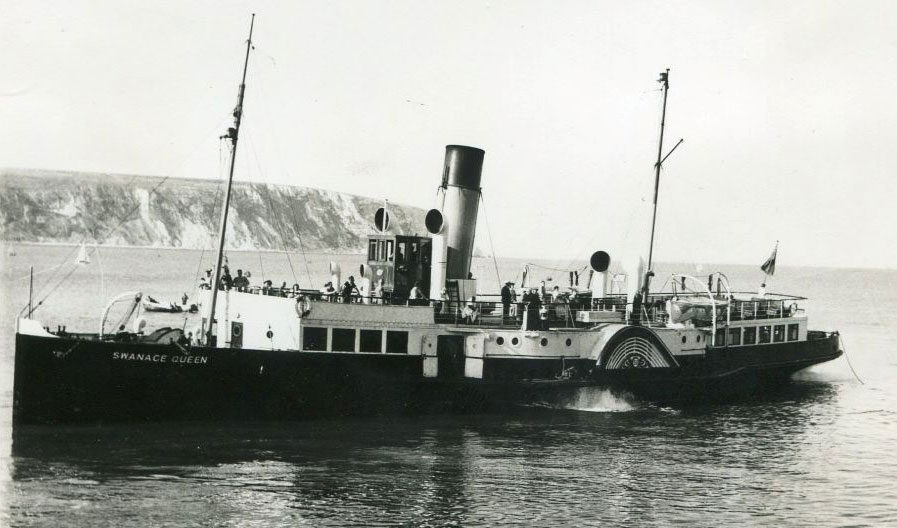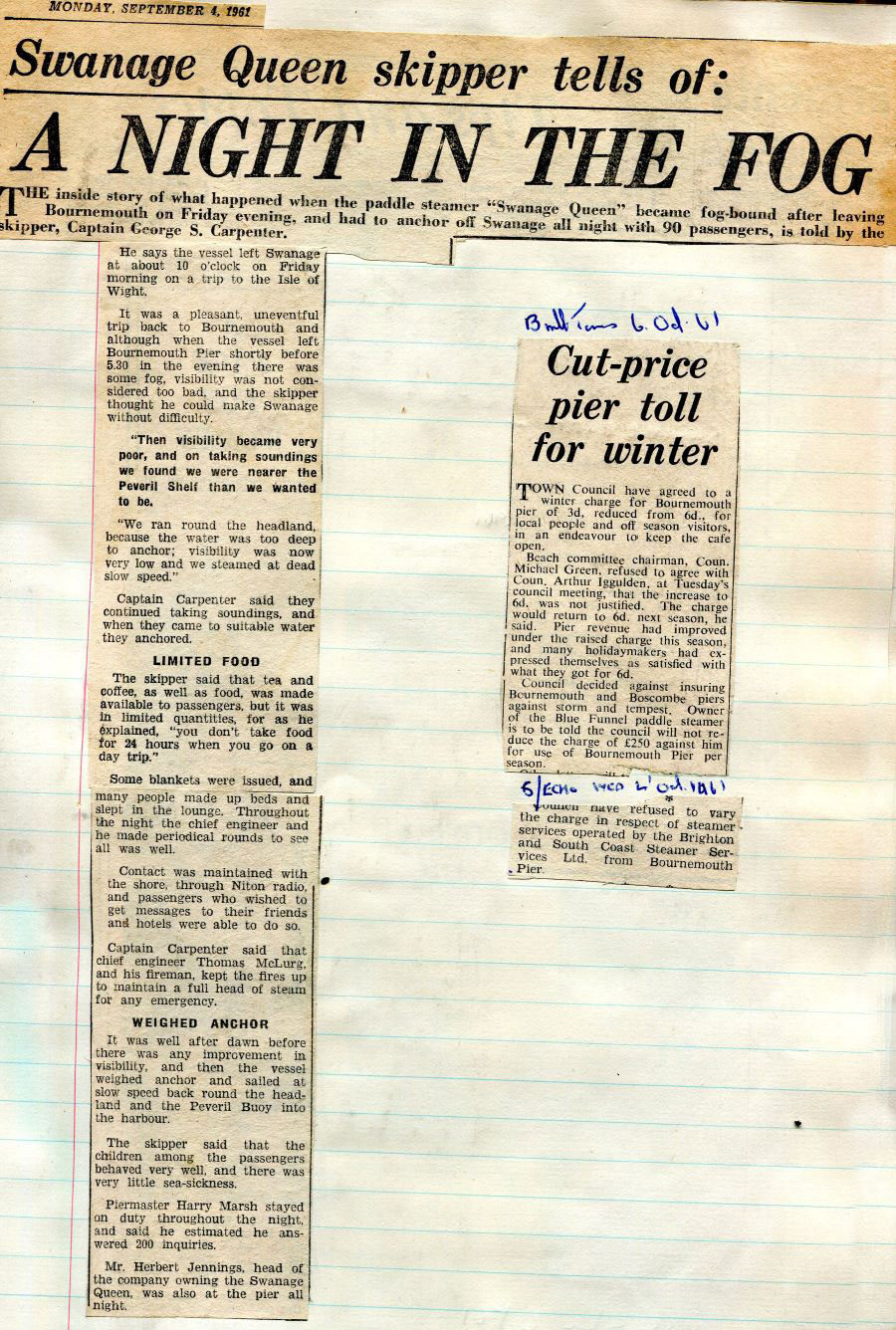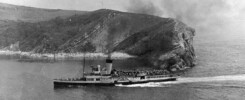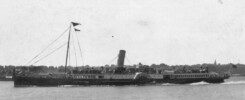
Swanage Queen ex Sussex Queen ex Freshwater did not have a good season at Bournemouth in 1961. Her owner Herbert Jennings had brought her to this Hampshire resort, after a terrible season trying to run her on the Sussex Coast as Sussex Queen in 1960, on the basis that Cosens had withdrawn their Monarch leaving a potential gap to be filled in the market on the Swanage service. What Mr Jennings had not bargained for was that Cosens had got into bed with Croson, who operated a small fleet of large motor launches including Fairmiles from Bournemouth, and together they offered a full Swanage service every day. Cosens and Croson had all the best timings between them for this so that when Swanage Queen turned up at the times allocated for her trips most of the custom had already been snapped up and sailed away with the established operators.
Then there were all the issues with Swanage Queen herself, her crew and her management. After lengthy battles with the Board of Trade she made a test run to Swanage on 5th July but collided with Hamworthy Quay in the doing of it and was out of service for the following couple of days with condenser trouble. Then on 9th July she started again but had to be withdrawn the same afternoon with a burst boiler tube. Then came a spell of poor weather with strong winds so it was not until 17th July that she put in a full day’s work on the Bournemouth/Swanage service.
Almost every day from then on there were further difficulties. Sourcing coal and getting it loaded was ever an issue. On 7th August the engine room telegraph broke. On 9th there was a problem with the steering. On 11th she was in collision with a yacht which tried to claim £1,000 for damage. Herbert Jennings stayed aboard himself on several occasions trying to rectify faults and on one of these days arrived to find the furnaces charged with fiercely burning coal with nobody in attendance and on another the boiler gauge glasses empty. On 16th August there was a complaint to the BOT that the ship had a serious list which Mr Jennings put down to poor trimming of the coal bunkers. On 26th August fires were not lit with Swanage Queen out of action for four days.
Then on Friday 1st September Swanage Queen was caught out in fog on the evening run from Bournemouth at 5.30pm to Swanage and ended up spending the night at anchor near Swanage with 90 passengers aboard. This drew more unwelcome press attention.

The following morning it was still foggy but not quite so bad as on the Friday night so Capt Carpenter raised the anchor and groped his way towards Swanage Pier listening out for the pier bell to guide him in. In this he was successful but with the fog still thick in places his angle of approach to the pier was wrong so he backed off only to become entangled with the fishing vessel Lucky Me which was on a mooring off the pier. Councillor Jim Hardy a member of the Swanage lifeboat crew, said ” It was a piece of extreme ill fortune for the captain of the Swanage Queen for he did a magnificent job to get her in in those circumstances in the first place.”
Then on 5th September the bilges were found to be full of water. Whether this was a result of incompetence on behalf of the engineer/boiler crew or malicious intent I don’t know but Mr Jennings was quoted in the press as saying that he believed that the vessel had been deliberately sabotaged. And I can tell you that that is is easily done for anyone who knows how to do it. On most paddle steamers the circulating pump, which sucks in sea water for the condenser to cool the steam back to water to be pumped back into the boiler, has a secondary role as an emergency bilge pump and is therefore often fitted so that it can suck either from overboard or from the bilge. There is a valve for each. If both such valves are opened, or partly opened, then that just floods sea water straight into the engine room bilge. Many paddle steamers also had gate valves in their bulkheads so opening one or two of them would have allowed any flooding to extend from the engine and boiler room to other compartments forward and aft.
Alternatively perhaps it was just an accident. All paddle steamers have a reserve feed tank for topping up the boiler if required. Although small in comparison with the size of the boiler itself these tanks can take quite a while to fill particularly if the shore fresh water supply is not generous and is coming aboard through, say, a garden hose rather than a fire hydrant. Maybe the stoker started filling the tank with fresh water, got bored waiting for it to fill up so went off to do something else aiming to return later. Maybe he went off in the meantime with his mates to one of the several pubs on Poole Quay for a pint, which may have turned into more than one pint, and then maybe he just forgot about it leaving the hose on with the feed tank quietly spilling over into the bilge.
Another explanation is that it could have happened through incorrect use of the bilge and fire-main valve chest. Swanage Queen would have had a general service steam pump capable of sucking water either from any or all of the bilges in her various compartments and then discharging it overboard or sucking in sea water from overboard and delivering it to the fire hydrants. What the pump was used for would have been controlled by opening and shutting the various valves in the valve chest, the ship side sea water suction inlet and any other valves in the lines. It is not a difficult process but getting it right and opening and/or closing the right valves in the various lines in the right order is crucial. It is standard practice for all of these valves to be closed at the end of the day but this may not have been done on Swanage Queen. Maybe the engine room routine was a little bit slack and valves were sometimes left open when they should have been shut. Then with the sea water inlet valve open, it is perfectly possible for sea water to siphon in of its own accord through into the valve chest and then pass on to any bilge line/s through any valves which have been left open in that. In theory this shouldn’t happen as each line would have been fitted with a non-return valve specifically to prevent this but, in my experience, non-return valves can get a bit sticky sometimes and may get a bit of crud sucked out from a bilge stuck under them, and thereby jamming them slightly open, giving a free route for sea water to pass straight through and on into a bilge. I think that we will never know the exact cause but fortunately the flooding was caught in sufficient time to prevent Swanage Queen sinking although not before the level of water was up to the floor boards in the lower saloon with the ship herself 6ins down on her marks.
On 9th September Mr Jennings personally supervised the loading of coal and saw Swanage Queen depart “all trim and on an even keel” but when he saw her the next day she had such a list that the “port paddle wheel was almost completely out of the water”. 11th September was her last day in service before sailing back for winter lay-up at Topsham on the River Exe near where Mr Jennings lived. That was her last voyage in steam. In May 1962 she was towed away to be scrapped in Bruges and Mr Jennings’s company Brighton and South Coast Steamers Limited went into liquidation.
It was a sad and sorry story which was to be repeated by others during the 1960s who bought up and tried to run elderly paddle steamers sold off by their long standing owners. All were confronted by similar problems. The paddlers themselves were getting on a bit and in need of costly repairs and renewals. The crews were employed on a seasonal basis and as ever when fishing in that pool you are a prisoner of what you can get. There was hostility from other operators bent on finding ways to close them down. Then there was one logistical problem after another some which would have taxed even the most seasoned and experienced passenger ship operator. Nonetheless I admire Mr Jennings for having a go. He put his money where his mouth was and he might have made a success of it had he not been confronted by hurdles so large that they eventually swallowed up and swept away his business.
However Swanage Queen left one legacy at Bournemouth. Later in the season on Fridays Mr Jennings inaugurated cheap day excursions to Yarmouth, Isle of Wight leaving Bournemouth at 10.30am and getting back by 5.30pm giving 4 hours ashore. This contrasted with Cosens’s usual timings for a longer day trip to the Isle of Wight which typically offered departures at 10am with return at 6.30pm or 6.45pm. The shorter day worked very well drawing some of Swanage Queen’s largest passenger loadings and Cosens noticed this. From the following year, until Embassy’s last season in 1966, they themselves also tapped into this market segment and offered cheap day excursions to the Isle of Wight on Embassy in the peak weeks on one, and sometimes two, days a week advertised to Mr Jennings’s timings.
Kingswear Castle returned to service in 2023 after the first part of a major rebuild which is designed to set her up for the next 25 years running on the River Dart. The Paddle Steamer Kingswear Castle Trust is now fund raising for the second phase of the rebuild. You can read more about the rebuilds and how you can help if you can here.
John Megoran


